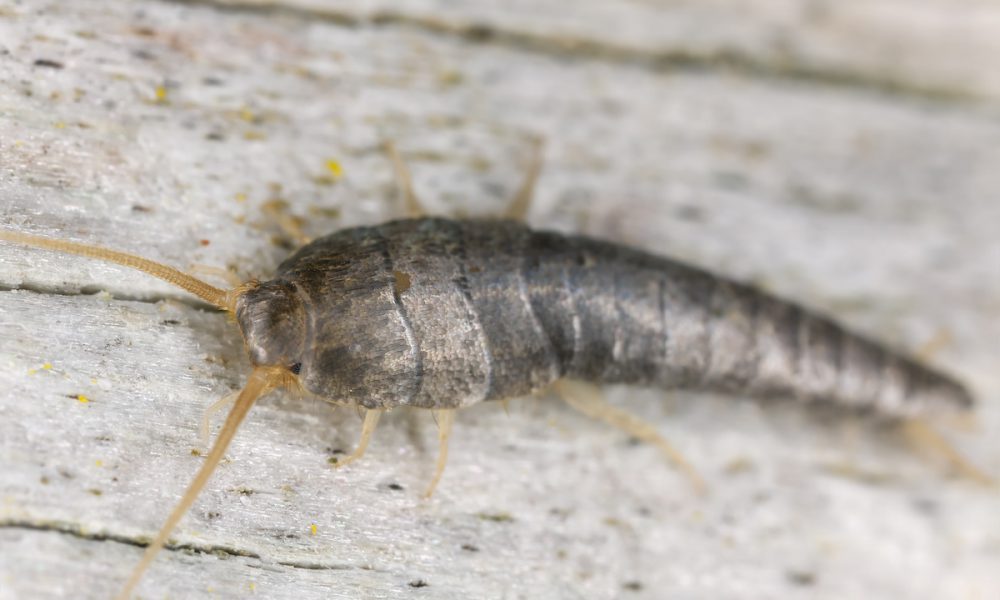
Silverfish’s name is derived from the insect’s silvery, metallic appearance and fish-like shape and movements. Because of their three long, bristle-like or tail-like appendages on the rear end of their body, Silverfish are also known as “bristletails”.
What is a Silverfish?
A silverfish is in the order of Zygentomas. They are a small, wingless insect. However, the scientific name indicates the Silverfish’s diet consists of carbohydrates such as sugar or starches. They are a chiefly nocturnal silvery bristletail that frequents houses and other buildings, feeding on starchy materials.
Appearance
They are a silver-colored fish, especially a variety of goldfish. The easiest way to identify a silverfish infestation is by seeing them with your own eyes.
Silverfish Features:
- No wings
- Able to run very fast
- Body length of about ½-3/4” (12-19 mm) not including the tail
- Flattened body
- Shape is compared to a teardrop, carrot or fish
- Covered with scales
- Long, threadlike antennas
- Small compound eyes that are widely separated
Habitat
While Silverfish may prefer humid environments such as bathrooms, they can often be found in kitchens as well. Check any containers of cereal, pasta, or rice, as they are drawn to the starchy foods inside.
Located
Silverfish are found throughout the U.S. They are seen in humid, moist areas of your home, such as basements, bathrooms, kitchens, and attics.
How do they get in your home?
Silverfish enter homes through foundation cracks, torn screens, or gaps around doors. They can also be brought inside the house through cardboard boxes and plastic containers recently stored in infested areas that allow the pests to spread. Warm and moist spaces, like basements, crawl spaces, kitchens, and bathrooms attract Silverfish. Silverfish can drop on your from a wall or ceiling.
Do they cause damage?
Silverfish are harmless to humans. They do cause damage to books, papers, clothing, food in pantries and wallpaper. Silverfish bite, leave small holes in materials and may also cause yellow staining.
Diet
Silverfish prefer foods that are high in starches, proteins, and sugars and, if inside a home, can often be found feeding on fabrics, paper, wallpaper, vegetables, pasta, sugar, toothpaste, cardboard, or even dead insects.
Might indicate a bigger problem
If you see Silverfish in your home, it could mean you have a water issue such as standing water or a water leak. When rain water gets into places it shouldn’t, it can cause mold, mildew, fungi, algae, and other things to grow. These natural organisms can soften wood and make it more susceptible to bugs and rodents. As these gaps form and areas are chewed, it gives access to Silverfish.
Lifespan
Silverfish have a lifespan ranging from two to eight years, and they generally reproduce through eggs laid by female Silverfish. The average female Silverfish lay up to 100 eggs during her life.
Silverfish are nuisance pests and some time may require experts help. If you are facing silverfish infestation, you should take care of it before it can get out of control. Removal of Silverfish can be a time-consuming and challenging process and in many cases require expert and professional knowledge.
Contact Houseman Services at 866-964-PEST as soon as possible so we can treat your property?
Houseman Services is the only complete service company in the Athens, GA area. We provide Weed control, fertilization, shrub care, mulch & pine straw, sod, annual plantings, irrigation, and commercial & residential lawn maintenance. We are also state certified and licensed in wood destroying organisms (termite control), household pest control, public health, and turf & ornamental weed control. We are licensed to control and treat mosquitoes, termites, all pest problems and turf & ornamental weed control. Contact the professionals at Houseman Services and set up a free inspection of your yard. We have been servicing homes and businesses in the Athens, Clarke County area since 1985!